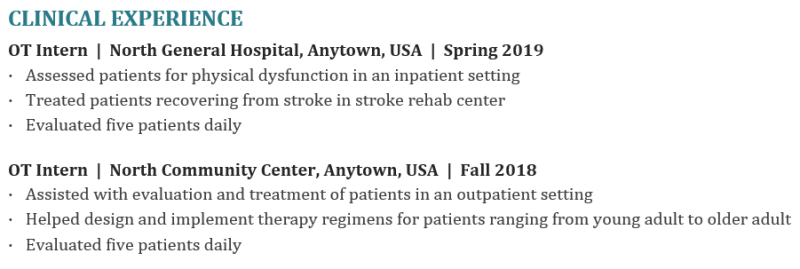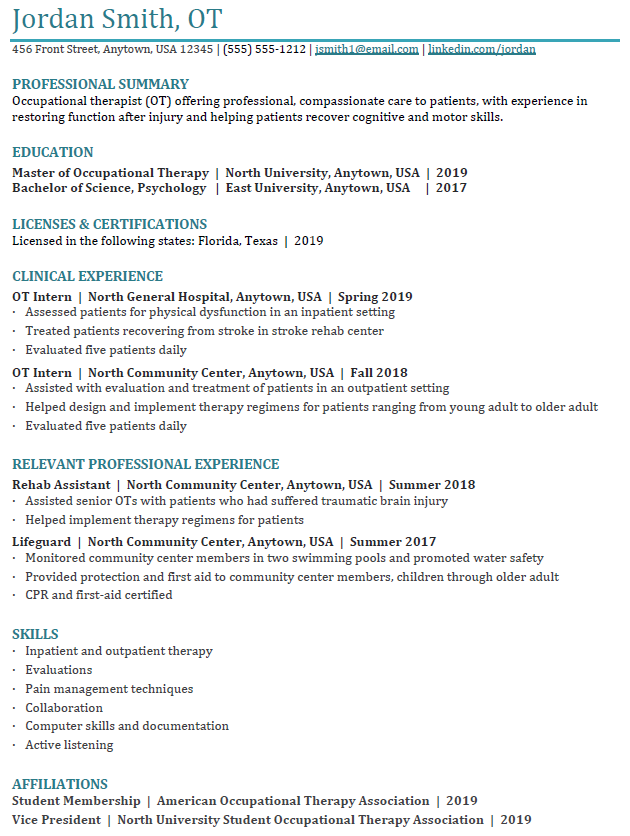Topics on this page:

With occupational therapy school in your rear-view mirror, it’s time to start focusing on the next step in your career: getting your first job! One of the most critical aspects of job-hunting is having a solid resume that can help you get your foot in the door with prospective employers. After all, your resume is (typically) a hiring manager’s first impression of you. It gives them a high-level overview of who you are as a job candidate and whether you could be a good fit for their role. The ultimate goal of your resume should be to make yourself stand out so the hiring managers have no choice but to call you in for an interview.
That said, there are right ways to format a resume…and there are wrong ways. To help you start your job hunt on the right foot, we asked Elizabeth DeIuliis, OTD, MOT, OTR/L, CLA, assistant department chairperson, director of clinical and community education and academic fieldwork coordinator in the Department of Occupational Therapy at Duquesne University, to share her insights about how to craft the perfect OT resume.
When you’re applying for entry-level OT positions — whether you’re a recent graduate or a young professional with little work experience — it’s typically expected that your resume will be one page long. In fact, it’s easier to read and keep organized when it is.
Another tip? Hiring managers expect to see your most recent achievements at the top of each section. Meaning, if you’re a new grad, you can put your education at the top. But once you’ve been hired as an OT, your work experience goes first and your education moves farther down the page. As for what to include within each position, list only a few points or accomplishments.
More bullets can be added for OT-related work.
No matter the specific profession, healthcare resumes typically follow a standard format. Below, we’ve provided a list of the different sections that every OT resume should include, as well as the order in which they typically appear:
Now let’s dig into what you should include in each section.
First thing’s first: You need to provide your personal information. This should always be listed clearly at the top of your resume. Here’s the kind of information that hiring managers expect to see:
For consistency’s sake, make sure to list the same exact contact information on your resume and cover letter. Also, be sure that you have a professional-sounding email address so that prospective employers take you seriously. (Believe us: As much as you might’ve once loved mermaids and unicorns, chances are that an email address like iloveunicorns92@email.com or mermaidgirl18@email.com won’t make the best first impression.) Don’t have an address that you feel comfortable using? No problem. You can easily create a brand new Gmail account and designate it for professional use only.
If you’ve already graduated and are licensed, be sure to list any credentials after your name (e.g., OTD, MOT, OTA) because they indicate competence, value, and accreditation. If you aren’t licensed or credentialed yet, you shouldn’t include anything after your name in the contact information section.
If you have a professional portfolio that you’re proud to share, you can include a link to it at the top of your resume, too. Some people also choose to include a link to their personal website or LinkedIn profile, as well.

This is an example of the proper way to format your contact information on an OT resume.

This is an example of what not to do when listing contact information on a resume. Note the use of an unprofessional email address.
Before delving into their clinical experience, many seasoned OTs tend to include a brief summary of their professional background toward the top of the resume. But if you’re just coming out of OT school, you may find that you don’t have much work experience to highlight. That’s OK! Instead, focus on describing the various skills, strengths, and experiences that you feel set you apart as a job candidate. This is also where you can mention any unique skills you have that could help you stand out from the rest of the entry-level applicants. Do you have special training or proficiency in a foreign language? Those types of extra skills and training could help you catch the eye of the hiring manager reviewing your resume.
Keep in mind that this section should not read like a “want ad” or state an objective about the job you’re seeking. Instead, it should sound more like a third-person bio about you, highlighting your best professional qualities.

This is an example of a properly written Professional Summary for an occupational therapy resume.

This is an example of what not to do when writing a Professional Summary for an occupational therapy resume. Note that it reads more like a “want” ad and less like a bio.
This section of your resume should be brief and straightforward. Simply list the degrees you earned, the schools you attended, and the year in which you graduated. It’s best to include this information as snippets, rather than within a paragraph of text; it’ll make it easier for hiring managers to quickly scan for the information that they want to know about you. Also, be sure to list your education history in reverse chronological order.
It’s worth noting that the placement of the Education section will change as you gain more professional experience. When you’re a new grad looking for your first job, it’s fine to have the Education section higher up on your resume – ideally, it should come right after the Professional Summary. However, once you have one or two jobs under your belt, consider moving the Education section toward the bottom of your resume so your work experience can more easily catch the hiring manager’s attention.

This is an example of how to properly format the Education section of an occupational therapy resume.

This is another example of what not to do when formatting the Education section of a resume. Note that the dates should be in descending (or reverse) chronological order, not ascending.
This is a short but necessary section to include within your resume because this is where you’ll list all your license and credentialing information. If you aren’t licensed or credentialed yet, you can indicate when you intend to apply for your license or sit for your board exam.

This is an example of how to properly format the Licenses & Certifications section of an occupational therapy resume.
It’s important to describe the highlights of your fieldwork during OT school because this can give the hiring manager a better understanding of your knowledge, skills, and areas of expertise. The best way to format your experience is by using bullets, which makes it easier for hiring managers to quickly scan so they can find out what they want to know about you. List your fieldwork in reverse chronological order, and use each bullet to describe tasks or skills that you acquired as a result of that experience.
It’s expected that you list hard skills here, but you can also list soft skills that help you look marketable to (most) employers’ needs — these can include skills like self-management, being timely in documentation, and meeting productivity in caseloads. Keep in mind that when we say “marketable,” we’re talking about skills you have that could make an employer’s life easier, such as the ones mentioned above. It’s not worthwhile to mention things like “pays attention to detail” or “enthusiastic learner.” While they’re certainly positives, they don’t directly solve an employer’s problem.
Be sure to use powerful action verbs to explain what you did. This will help prevent you from speaking in the passive voice. And don’t include chunky paragraphs instead of quick-to-read bullet points; the important details about your experience may be overlooked if they’re buried within text.

This is an example of how to properly format the Clinical Experience section of an occupational therapy resume.

This is an example of what not to do when formatting the Clinical Experience section of an occupational therapy resume. Note that the information isn’t in bullet form, making it hard to scan.
Here, you should list, in reverse chronological order, any volunteer or paid positions that are relevant to occupational therapy, with bullets to describe what you did on the job. Even some outside positions that you’ve held may be worth highlighting, as long as they’re relevant to the job you’re applying for. For example, if you were a lifeguard during your summer break for the past few years, you can list that, along with your CPR and first aid certifications. These experiences will help demonstrate your sense of responsibility and may set you apart from other applicants. If you’ve worked your way through school in retail, it’s commendable but not worth mentioning on your OT resume.

This is an example of how to properly format the Relevant Professional Experience section of an occupational therapy resume.

This is an example of what not to include in the Relevant Professional Experience section of an occupational therapy resume. Note that the job listed isn’t relevant to the position for which you’re applying.
Hiring managers will expect you to tease out some of your most marketable skills within a short, bulleted section. This will help them get a clear picture of what you believe are your most notable strengths. When you create this list, consider what a hiring manager would want in a new employee. An easy way to do this is by looking at the role’s job description and see what skills they’re looking for. Then, identify the ones that you know you have and highlight them on your resume. Make sure to tailor this section to each job you’re applying to, and to the specific skills each employer is looking for.
It goes without saying, but you should also NEVER claim to have a particular skill that you don’t have. Yes, if a prospective employer is looking for bilingual OTs, saying you’re fluent in Spanish probably could boost your chances of getting an interview. But if you’re not actually fluent — or, worse, have never even taken a class — you could find yourself in a very awkward situation if the interviewer starts asking you questions in Spanish. (That would be no bueno.)

This is an example of how to properly format the Skills section of an occupational therapy resume.

This is an example of what not to do when formatting the Skills section of an occupational therapy resume. Note that the items listed aren’t technically skills or strengths – they’re actions.
Within this short, list-style section, include any affiliations that you have, whether they’re professional memberships, volunteer opportunities, or leadership roles that you’ve taken on during OT school. Listing these details can show a hiring manager that you have leadership skills and the ability to work as part of a team. You also could consider including details about your academic research here, particularly if you presented details about it at your university or at a conference. This piece of information shows a real commitment to your profession, and hiring managers love to see that in potential job candidates.

This is an example of how to properly format the Affiliations section of an occupational therapy resume.
Your completed resume should look something like this:

This is an example of an ideal resume for an entry-level occupational therapy position.
After you create a first draft of your resume, ask yourself the following questions while you tweak the details so you end up with an impressive documentation of your educational and work history:
Image courtesy of iStock.com/dima_sidelnikov
Last updated on Jul 24, 2024.
Originally published on Jun 24, 2019.
More:
The views expressed in this article are those of the author and do not necessarily reflect those of Berxi™ or Berkshire Hathaway Specialty Insurance Company. This article (subject to change without notice) is for informational purposes only, and does not constitute professional advice. Click here to read our full disclaimer
The product descriptions provided here are only brief summaries and may be changed without notice. The full coverage terms and details, including limitations and exclusions, are contained in the insurance policy. If you have questions about coverage available under our plans, please review the policy or contact us at 833-242-3794 or support@berxi.com. “20% savings” is based on industry pricing averages.
Berxi™ is a part of Berkshire Hathaway Specialty Insurance (BHSI). Insurance products are distributed through Berkshire Hathaway Global Insurance Services, California License # 0K09397. BHSI is part of Berkshire Hathaway’s National Indemnity group of insurance companies, consisting of National Indemnity and its affiliates, which hold financial strength ratings of A++ from AM Best and AA+ from Standard & Poor’s. The rating scales can be found at www.ambest.com and www.standardandpoors.com, respectively.
No warranty, guarantee, or representation, either expressed or implied, is made as to the correctness, accuracy, completeness, adequacy, or sufficiency of any representation or information. Any opinions expressed herein are subject to change without notice.
The information on this web site is not intended or implied to be a substitute for professional medical advice, diagnosis or treatment, and does not purport to establish a standard of care under any circumstances. All content, including text, graphics, images and information, contained on or available through this web site is for general information purposes only based upon the information available at the time of presentation, and does not constitute medical, legal, regulatory, compliance, financial, professional, or any other advice.
BHSI makes no representation and assumes no responsibility or liability for the accuracy of information contained on or available through this web site, and such information is subject to change without notice. You are encouraged to consider and confirm any information obtained from or through this web site with other sources, and review all information regarding any medical condition or treatment with your physician or medical care provider. NEVER DISREGARD PROFESSIONAL MEDICAL ADVICE OR DELAY SEEKING MEDICAL TREATMENT BECAUSE OF SOMETHING THAT YOU HAVE READ ON OR ACCESSED THROUGH THIS WEB SITE.
BHSI is not a medical organization, and does not recommend, endorse or make any representation about the efficacy, appropriateness or suitability of any specific tests, products, procedures, treatments, services, opinions, health care providers or other information contained on or available through this web site. BHSI IS NOT RESPONSIBLE FOR, AND EXPRESSLY DISCLAIMS ALL LIABILITY FOR, ANY ADVICE, COURSE OF TREATMENT, DIAGNOSIS OR ANY OTHER SERVICES OR PRODUCTS THAT YOU OBTAIN AFTER REVIEWING THIS WEB SITE.
Click to collapse disclamerWant Berxi articles delivered straight to your inbox? Sign up for our monthly newsletter below!
"*" indicates required fields